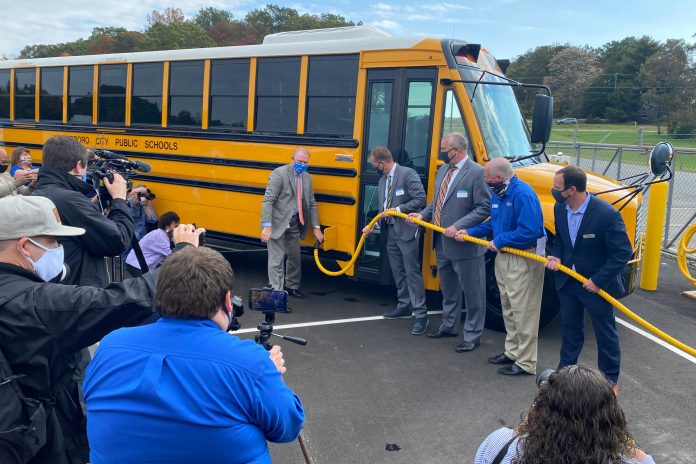In wake of widespread economic disruption caused by the novel coronavirus pandemic, policymakers worldwide are preparing recovery packages to support businesses, create jobs and reinforce school districts. The electric bus industry will likely be among the key contenders for stimulus funding given its significant environmental and economic contributions, both now and into the future.
President Joe Biden’s recent infrastructure plan includes goals to accelerate progress towards converting the country’s 500,000 school buses, including diesel buses, to zero emissions by 2030. Besides climate change and long-term economic benefits, the impact of conventional diesel-powered buses on children’s health, and performance have recently emerged as key enablers fueling the electric bus trend.
According to a 2019 study published by the Brookings Institution, reducing a child’s exposure to diesel emissions could lead to a significant improvement in health and cognitive function. The researchers also observed noteworthy test score gains along with improvement in respiratory health among children exposed to lower levels of diesel emissions.
As support for electric mobility continues to increase, federal agencies are turning their sights on school buses. The global market for electric buses could reach a value of over $53 billion by 2027, claims Global Market Insights, Inc.
Active Electrification Efforts of School Fleets Across California
Electric buses had a negligible market presence up until a few years ago. However, that has now changed thanks to innovative financing mechanisms and declining battery prices. More and more bus fleets in the U.S. are now going electric backed by specialized grants and funding programs.
The Los Angeles Unified School District (LAUSD), for instance, ordered 10 new all-electric school buses in March 2021 as part of its goal to accelerate the replacement of diesel buses. California Energy Commission’s School Bus Replacement Program funded the purchase.
A single electric bus could help save around $10,000 in maintenance costs annually while reducing greenhouse gas emissions by up to 54,000 pounds each year, LAUSD Superintendent Austin Beutner noted. The electric buses are expected to be delivered sometime this spring.
Meanwhile, Santa Cruz City Schools (SCCS) also began large-scale conversion to electric buses in April as students are back to school campuses.
Reportedly, SCCS received grant funding through a recent incentive program by the Monterey Bay Air Resources Board. The Monterey Bay Community Power funded a portion of this program with a $1.2 million contribution, which will be used to fund $200,000 grants through six school districts across Santa Cruz, Monterey, and San Benito.
Evidently, public agencies and utility firms are keen to fund and support electrification plans of local institutions for strengthening their community and expanding their foothold in the sustainable economy. Notable partnerships can lead to a gradual reduction in the overall cost of running and maintaining an electric fleet.
Palermo Union School District in California’s Butte County said it plans to add a new small electric bus to its fleet, which currently has five buses, later in the year. The school district received funding of $85,237 through the Butte County Air Quality Management District and PGE and is partnering with Amply Power in a bid to reduce electricity costs by up to 50 percent.
Expanding Sustainability Efforts Across East Coast Schools
In the New York town of Bethlehem, school district residents will vote this month to decide on a $1.675 million proposition to replace nine large 2009 diesel buses with new all-electric ones. The purchase will be partially funded through a grant from the New York State Energy Research and Development Authority (NYSERDA). The proposition cost will cover the buses along with the necessary charging infrastructure costs.
The East Coast is also witnessing considerable public investment for increasing the contribution of schools toward reducing carbon emissions. Larger school districts are setting notable examples for other counties, with key initiatives aimed at future sustainability.
Maryland’s Montgomery County Public Schools disclosed plans in February to roll out hundreds of new electric school buses in an effort to reduce diesel emissions, that impact both the environment and the health of students. The Montgomery County School Board approved the $1.3 million annual contract. It is among the largest single district project in the country to replace diesel buses with electric buses. By 2035, the county aims to swap its entire fleet of about 1,422 buses with zero-emission vehicles.
Also in February, New Jersey Gov. Phil Murphy announced funding worth $100 million in grants to help towns purchase heavy-duty electric vehicles, including electric school buses, and build necessary charging infrastructure to meet sustainability goals.
Future of Buses in the Electric Mobility Space
Even with extensive funding programs, electric bus adoption worldwide is limited in scale. High upfront costs and expenses such as licensing costs, interest on loans, insurance costs, storage costs, and taxes remain key obstacles to the widespread adoption of electric buses in schools.
The lack of standardized charging infrastructure and not to mention the impact of the COVID-19 pandemic could slow down electric bus industry trends to some extent.
However, positive efforts such as Shell’s plans to build over 500,000 new electric charging stations across the U.S. by 2025 indicate signs of an EV charging infrastructure boom that could prompt public authorities and private investors to pour cash into the electric bus industry.
 A graduate in electronics and telecommunication engineering, Hrishikesh Kadam has always found writing fascinating. Driven by a never-ending passion for content creation combined with a bit of experience in writing personal blogs, Hrishikesh blends his technical knowledge and expertise to pen down articles for numerous online portals.
A graduate in electronics and telecommunication engineering, Hrishikesh Kadam has always found writing fascinating. Driven by a never-ending passion for content creation combined with a bit of experience in writing personal blogs, Hrishikesh blends his technical knowledge and expertise to pen down articles for numerous online portals.
















